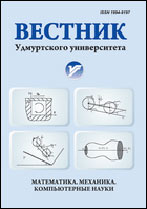|
|
Vestnik Udmurtskogo Universiteta. Matematika. Mekhanika. Komp'yuternye Nauki, 2014, Issue 2, Pages 121–145
(Mi vuu432)
|
 |
|
 |
MECHANICS
Irregular and regular forces in stellar systems
L. P. Ossipkov
Saint Petersburg State University, Universitetskii pr., 35, Staryi Peterhof, Saint Petersburg, 198504, Russia
Abstract:
Various ways of definition of irregular (random) and regular (smoothed) forces in stellar systems are critically discussed. The most satisfactory is Eddington's one according to which the regular force is an attraction force of a continuous fluid resulting from spreading a stellar mass over a system. Also, a definition of the regular force as a mathematical expectation of a random force is of interest. It is emphasized that the crossing time, $\tau_c$, a time scale of regular forces, characterizes the rate of collective processes in the system, including collisionless relaxation, that (as a rule) occurs in gravitating systems. The quasi-entropy, i.e., a result of averaging of an arbitrary convex function of a coarse-grained distribution function over the phase space, is discussed as a measure of collisionless stochastization. For non-rotating systems the maximum of quasi-entropy can be reached only for isotropic velocity distributions. Formulas for the first and second variations of quasi-entropy, found by Antonov, are given. If there exists the density variation so that the second variation of quasi-entropy is positive, then the present state of the system is not the most probable. It follows from this assertion that evolution along a sequence of polytropic spheres is not possible without some energy input to the system. We recall the classification of forms of the phase mixing in collisionless systems.
The problem of collisional relaxation in gravitating systems is briefly discussed. We state the approach to its analysis on the basis of studying geodesic flows and the ensemble averaging as the next step, which requires the knowledge of distribution of a random force. To avoid truncation of Holtsmark's distribution at small impact parameters the distribution of random force by Petrovskaya was used. In that case the ratio of the effective stochastization time to the crossing time is proportional to $N^{1/3}/(\ln N)^{1/2}$ where $N\gg 1$ is the number of stars in the system. This evolutionary time scale is close to the one found earlier by Genkin.
Keywords:
dynamics of stellar systems, modelling stellar systems, evolution of galaxies.
Received: 16.01.2014
Citation:
L. P. Ossipkov, “Irregular and regular forces in stellar systems”, Vestn. Udmurtsk. Univ. Mat. Mekh. Komp. Nauki, 2014, no. 2, 121–145
Linking options:
https://www.mathnet.ru/eng/vuu432 https://www.mathnet.ru/eng/vuu/y2014/i2/p121
|

|




 Contact us:
Contact us: Terms of Use
Terms of Use
 Registration to the website
Registration to the website Logotypes
Logotypes








 Citation in format
Citation in format 